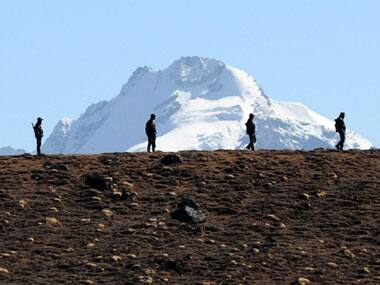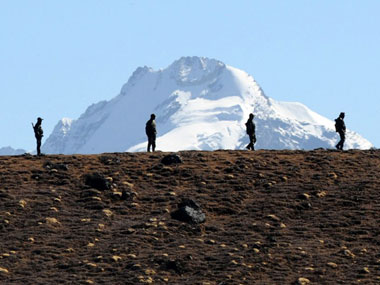China has come up with yet another provocation. The Chinese state-run media has just described the disputed Gilgit-Baltistan region in Pakistan occupied Kashmir as ‘Pakistan’, thus taking sides with Pakistan at the expense of India in the 67-year-old India-Pakistan conflict over Kashmir. [caption id=“attachment_1833679” align=“alignleft” width=“380”]  Representational image. AFP[/caption] While reporting closure of the Khunjerab Pass, a highly strategic road which links China’s far-western Xinjiang region and PoK, for the winter season, China’s state-run Xinhua news agency described the pass as “a strategic point on the Karakoram highway which links China’s Xinjiang with Pakistan’s Gilgit-Baltistan region”. The full text of the Xinhua dispatch can be seen here. Entire media in China is state-owned and it is rare for the state-controlled Chinese media to err while describing international boundaries. Several questions arise when one goes through the above-mentioned Xinhua report. Is it a genuine mistake on part of Xinhua? Or is it a deliberate ‘mistake’ by Xinhua floated as a trial balloon to test the Indians? Or worse, is it a carefully choreographed conscious move by Beijing having much larger strategic and diplomatic repercussions the consequences of which have already been taken into account by the Chinese government? China has been known to drop subtle hints of its upcoming diplomatic and strategic moves through its state-controlled media. Often such reports by the Chinese state-controlled media are the trial balloons to test the patience of the targeted country and elicit a response. If the response from the targeted country threatens to hit the Chinese diplomacy, Beijing quietly overrules such media reports and makes amends. This has been happening repeatedly in the India-China diplomatic engagement. In 2010, the Chinese media had quoted the Chinese Foreign Ministry statement denying the presence of its troops in PoK while describing the Gilgit-Baltistan region as “part of Pakistan”. After India cried foul and lodged a strong protest with Beijing, the Chinese foreign ministry and Xinhua news agency withdrew the statements from their websites. In this case too, the Indians are expected to come up with a strong protest (if they have not done so already!); but the eventual reaction of China will be of huge significance. Of the three questions mentioned above, this writer would go with the last scenario as the possible reason of the latest Chinese pinprick: that it is a carefully choreographed move by Beijing while the Chinese government has taken into account the inevitable strategic and diplomatic repercussions flowing from the move. The offensive Chinese move has come two days after China and Pakistan kicked off their multi-billion dollar Economic Corridor project that passes through the PoK by laying the foundation of an ambitious four-lane motorway project connecting the two countries. The China-Pakistan Economic Corridor project is essentially aimed at throttling India through a pincer strategy by the two nuclear-armed neighbours who have fought wars with India in the past when they were not nuclear weapon states. India has viewed the China Pakistan Economic Corridor project with lot of trepidation, but there is nothing much it can do about it. It is another matter that forging such infrastructural linkages with Pakistan, China may well be scoring a self goal as the proposed corridor would eventually expose China to risks of China-specific, Pakistan-based jihadists targeting China’s restive Muslim-dominated region of Xinjiang. Obviously Chinese statecraft has already taken into account all these and many more possible negative repercussions before embarking on the China-Pakistan Economic Corridor Project. Therefore, the only possible explanation for the latest Chinese bugbear in calling a disputed region of PoK as “Pakistan” is nothing but a part of a pincer strategy wherein China and Pakistan close ranks to take on India. The Chinese provocation has come days before the much-awaited diplomatically significant visit of Russian President Vladimir Putin to India. Besides, United States President Barack Obama is also scheduled to visit India as the Chief Guest for India’s Republic Day 2015. Equally significant is the fact that India has just successfully test launched its nuclear-capable Agni 4 missile which has large parts of Chinese territories under its ambit. Besides, India is poised to test Agni 5, its maiden ICBM (Inter Continental Ballistic Missile) with a range of 5000 kms within a month. All said, things are looking rather worrisome in the strategic context for India though India-China bilateral relations may ostensibly be presenting a rosy picture. The moral of the story is that India has to not only be cautious about China and Pakistan independently but also the very high degree of probability of the China-Pakistan pincer formation against India.
The offensive Chinese move has come two days after China and Pakistan kicked off their multi-billion dollar Economic Corridor project that passes through the PoK by laying the foundation of an ambitious four-lane motorway project connecting the two countries.
Advertisement
End of Article
Written by Rajeev Sharma
Consulting Editor, First Post. Strategic analyst. Political commentator. Twitter handle @Kishkindha. see more


)

)
)
)
)
)
)
)
)



